Dice City Review and Giveaway!
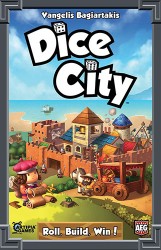
It’s time to build the best city around!
As the name so aptly describes, Dice City is a game about building your city using dice.
If you saw our review of Machi Koro last week, you may be thinking, “Didn’t I just read a review about a city-building dice game?”
While the short answer is “Yes”, the long answer is “We’ve got another game for you to check out – Dice City.”
The premise of Dice City may sound very similar to Machi Koro: Players are competing to build the best city around by rolling dice and acquiring cards to add to their city.
While both dice games are fun family games, Dice City delivers a very different game experience than Machi Koro.
We’ll run through a comparison of these two city-building dice games in just a bit. But first, we’ll give you a run down of how to play Dice City (then you can enter the giveaway contest).
How to Play Dice City
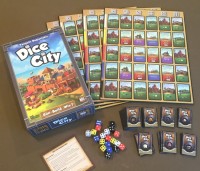
Playing Dice City is very straightforward. You’ll roll dice, gain resources, build locations, and hopefully win the game.
Set Up
Each player gets their own city board and 5 colored dice (white, yellow, red, blue, black).
The Lumber Mill, Quarry, Mine, and Regular Army cards are placed in their individual stacks in the center of the table.
The Location cards are shuffled together and 8 are drawn and placed face up next to the basic cards.
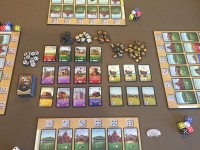
In addition, the Bandit cards and Trade Ship cards are also placed in their respective stacks.
All of the tokens (Resources, Pass, Deactivation, and Victory Points) are also set within reach of all players.
Once all the game items are in place, players simultaneously roll their 5 dice and place them on their city boards.
Down the left side of each city board are the 5 colors corresponding to each color of dice. To place their dice, players simply match the color of each die with the corresponding column and row. For example, if a player rolls a White 5, they place that die on the location in the 5th column of the white row.
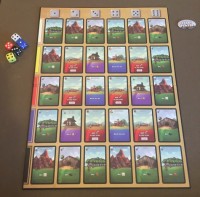
Then play begins with the starting player.
Taking a Turn
On a player’s turn, they take the following steps:
- Use Dice
- Attack
- Build and Trade
- End of Turn
1. Use Dice
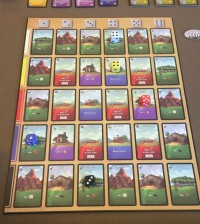
Since the dice are already on the player’s city board, they now simply use each die by removing it from a location and taking one of the following actions:
- Use the location ability of that spot
- Move another die to an adjacent spot in that die’s own row
- Discard 4 location cards in the market and draw new ones (can only be done once per turn)
- Reactivate a deactivated location anywhere in their city
- Gain a Pass token (can only be done once per turn)
The most common use of the dice will be to use the ability of the location it was on. Perhaps the next most common will be to remove one die to be able to move another die to an adjacent location in its row – so it can take advantage of a better location ability.
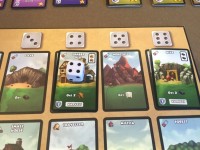
In addition to using their dice, players can also spend 2 Pass tokens to either Gain a resource of their choice, Increase their Army strength by 1, or force all other players to reroll one of their dice.
Once all dice are used (and any Pass tokens they choose), the player can Attack.
2. Attack
Some red (Military) locations have a sword icon on them. When a player uses these locations, they add strength to their military for that turn.
Using their total activated strength a player can perform one or more attacks. They can choose to either attack Bandits or Another Player.
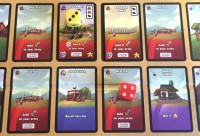
To attack a Bandit, the total military strength must be equal to or greater than the defense value on the Bandit card. The player then takes that Bandit card and places it facedown next to their city (to score the victory points on it at the end of the game).
When attacking another player, the active player chooses a location on the opponent’s city board to attack. And similar to a bandit card, they compare their military strength to the defensive strength (shield icon). If the military strength is equal to or greater than the defense, they place a Deactivation on the attacked location. If there is a Victory Point value (star icon) on that location, the attacking player also gains that many victory points.
Locations without a shield icon cannot be attacked.
Another element that can be attacked is an opponent’s stock of resources. A player can steal 1 resource for every 2 military strength they have.
After attacking, if a player has more military strength remaining, they may make another attack.
Military strength is only good for a single turn. Unlike resources, it cannot be stored or accumulated for a future turn.
3. Build and Trade
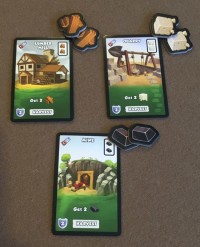
The active player can now spend their resources to build new locations in their city or use trade ships to export those resources and gain victory points.
The cost of each location is located in the upper-right corner of the card. A player simply returns the required resources to the central supply and takes the location card from the market. They then place it anywhere in their city.
By building a new location in their city, they’ll also be covering up an existing location. The covered location ability is no longer accessible when that number is rolled. Only the visible location ability is used.
In this manner, players essentially upgrade the locations in their city to achieve better abilities.
Players can build as many new locations as they have resources to spend on a turn.
To use a Trade Ship, the active player spends the required resources of a Trade Ship card. The player then takes that card and, like with a Bandit card, places it facedown near their city for scoring at the end of the game.
4. End of Turn
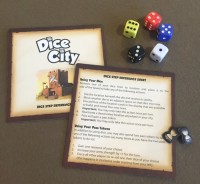
If the active player has any resources remaining, they can store one of each type. Those resources are considered to be in stock (these are the resources other players may steal in an attack). All other unspent resources are returned to the general supply.
Players can keep as many Pass tokens as they would like from turn to turn.
After storing any resources, the player then rolls their 5 dice and assigns them to their appropriate spots on their city board.
Then play continues to the player to the left.
End of Game
The game ends after one of these conditions is met:
- All Bandit cards have been taken
- All cards from any two stacks of Trade Ships have been taken
- The location deck runs out of cards
- Two or more rows in a player’s city have been filled with built locations (and none of them are currently deactivated)
Once that condition is met, play continues until every player has had an equal number of turns. (Thus, the use of the Starting Player token.)
Then players add up their victory points which include:
- Victory Point tokens
- Bandit cards
- Trade Ship cards
- All location cards in their city with VP (both active and deactivated)
The player with the most Victory Points is the winner.
Differences Between Dice City and Machi Koro
As we stated at the beginning, the premise Dice City sounds a lot like Machi Koro, which we reviewed last week.
By reading through how to play, we’re sure you’ve already spotted a number of obvious differences between Dice City and Machi Koro (number of dice, player boards, resources, trade ships and bandits).
So although the theme may be similar, both games offer a vastly different game playing experience. And depending on the type of game experience you’re looking for, you may prefer one over the other.
Here we’ll dive into 5 of the main differences.
City Size
In Machi Koro, each player begins with just 2 establishments (Wheat Field and Bakery) and build more establishments through the game. It’s a very simple city to start with and there are only 15 unique establishments to choose from.
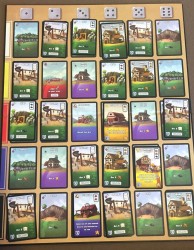
In Dice City a player’s starting city is comprised of 30 locations. Although some of those locations are duplicates (not unique), players can upgrade them by building new locations on top of them.
Experience: Machi Koro starts off very simply with players not having a lot of options in their cities. New players won’t be overwhelmed when they first sit down to play. The first couple of turns will feel like a tutorial as they get familiar with the game and slowly build up new establishments in their city. They’ll feel like they’re building a small city into a large one.
On the flip side, in Dice City players immediately can see there are a lot of options. Players will feel like they’ve already got a large city under their control with many options available. Although players can upgrade their locations, the extent of their city won’t expand. They’ll always have 30 locations in their city. In this way the game feels more like a city management game rather than a city-building game.
Use of Dice
In Machi Koro all players share 2 dice and take turns rolling. The outcome of a roll may impact all players in the game. Whether the result impacts only the player rolling or other players (depending on their establishments), the outcome is the same – players will gain (or lose) coins.
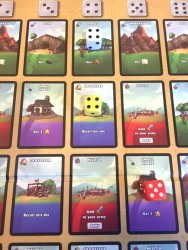
In Dice City each player has their own set of 5 dice and rolls them and assigns them to the appropriate spots on their board at the end of each of their turns. The outcome of each die roll depends on the location it activates in the city. Players also have options to use their dice for other actions than just the ability of a location they end up on.
Experience: The use of dice between the two games feels like night and day. In Machi Koro, players roll a die (or two) and immediately get coin rewards. There aren’t any choices to be made from the results. If a card says to get 1 coin, the player gets one coin.
In Dice City, players place their 5 dice in their city and each can be used for distinct actions. Because of this, while other players are taking their turns a player can contemplate how they’ll use those dice on their next turn. With options to move dice to adjacent locations, cycle locations from the market, or claim pass tokens, there’s plenty to evaluate to make optimal use of each die.
Resources
In Machi Koro, there is only one resource to gain and manage – Coins.
In Dice City, there are 3 resources to manage – Wood, Stone, Iron, and Military.
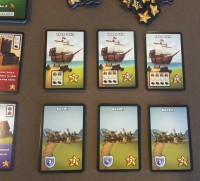
Experience: Although our world seems to revolve around money. Reality says there’s more to building a city than just throwing money at it. However, while playing Machi Koro, coins will take care of all a player’s needs. Having only one resource is a streamlined way to increase the strength of a city.
While playing Dice City, players gain and use wood, stone, and iron to build new locations and ship goods. Additionally, players have a military resource to manage for attacking bandits or other players. Managing multiple resources means more decisions to make.
Establishments and Locations
In both games, the structures in a city (establishments or locations) are represented by cards. For being dice-driven games, both involve a lot of cards.
In Machi Koro, all establishments revolve around money. Since money is the only resource in the game, the only ability an establishment can provide is a way to earn coin.
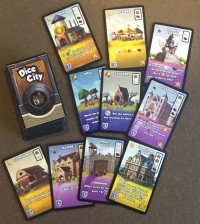
In Dice City, locations can do all sorts of things. Not only can they provide different resources, but they can also generate re-rolls, move dice, dish out victory points, provide defense, and other sorts of nifty combinations of actions.
Experience: The establishments in Machi Koro don’t offer a lot of variety. Each is just a slightly different spin on the same result. With only one resource to dish out, they only differences are whether a player earns coins on their turn or another player’s turn and whether they get coin from the bank or other players.
The locations in Dice City create more variety in how they interact with each other. But that’s not the only interesting thing about locations in the game. Since players make choices on where they place their new locations, every player’s city will take shape in different ways.
Attacking
In both games, the color Red signifies an attack.
In Machi Koro, the red and purple establishments allow players to take coins from other players (it’s not referred to in the game as an attack).
In Dice City, the red locations generate military strength for attacking.
Experience: In Machi Koro, an “attack” is carried out when the dice results match the number of a red or purple card. Players don’t have any choices in what to do when the result is rolled. It just happens. Bad luck for the person losing their money.
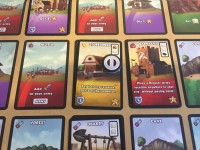
In Dice City, an “attack” is really a methodical outcome. Yes, the luck of the dice rolls will dictate is a red location gets a die placed on it. But it’s still up to that player to use that result for an attack or not. Since players can remove a die to move a different die or claim a pass token, they don’t have to attack. But if they want to, they can choose to target one specific opponent. And since that opponent already has their dice placed on their city locations, the active player can choose to attack one of those locations – thus, forcing the opponent to adjust their use of that die in their coming turn.
In addition, if a player wants to attack, they can build more red locations and distribute them in such a way in their city that their probability and power of attack increases. And even with that, the player may choose to use the military strength to not attack another player, but attack bandits instead.
Which Game to Get?
While there are more than just 5 differences between the two games, those we’ve listed are the major elements that create the distinct play experiences.
So when deciding which game to get, consider the factors above for the type of play experience you’re after.
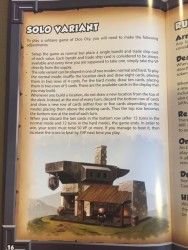
If you want a game that presents a broad range of decisions, then Dice City is the way to go. Because the game is based on dice rolls, there’s still a healthy element of luck involved in the game. But there are also plenty of ways to manipulate those results to your advantage through the choices you make.
On the other hand, if you’d like your dice-rolling game to be mostly driven by the luck of the die roll and only include a few decisions, then Machi Koro is the way to go.
While we don’t consider Dice City to be a deep, strategic game, it definitely has more depth and requires more thinking than Machi Koro. Machi Koro is clearly the lighter game of the two. Machi Koro also plays in half the time (30 minutes vs. 45-60 minutes).
So which will you choose?
Or will you be like us and add both to your game shelves?
Yep. We’ll be keeping both.
Like we always say, “the best game depends on the situation”. Sometimes we’ll be in the mood for one. And sometimes we’ll be in the mood for the other. With both games, we can choose in the moment.
How does Dice City score on our “Let’s Play Again” game meter?
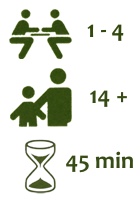 If our previous paragraph didn’t give it away, we’ll say it straight. Dice City is a game that we anticipate playing many times.
If our previous paragraph didn’t give it away, we’ll say it straight. Dice City is a game that we anticipate playing many times.
The games we enjoy playing repeatedly are those that have a good mix of strategy and luck.
In Dice City the dice rolls deliver the element of fun luck while the choices in what to do with the results keeps us thinking. That combination means there is still plenty for us to explore with the game.
Thanks AEG for Dice City – a fun family, dice, city-building game.
Dice City Game Giveaway!
If Dice City looks like a fun game, or if you just like trying to win stuff, then this game Giveaway is for you!
We’re giving away a copy of Dice City to a lucky winner!
No – we’re not giving away our copy because we’re hanging on to that one. We’re giving away a brand new, in-shrink copy of the game for one lucky visitor.
And that could be you!
To enter, or get multiple entries, simply complete the options in the Giveaway Contest box below.
This contest ends February 29, 2016 at 10:00 AM MST. The Board Game Family will cover shipping to the winner if located in the United States or Canada. If the winner is located outside the United States and Canada, he/she will need to cover shipping costs. Entry will also add you to our email list to receive future posts. The winner will be contacted by email by March 2, 2016.

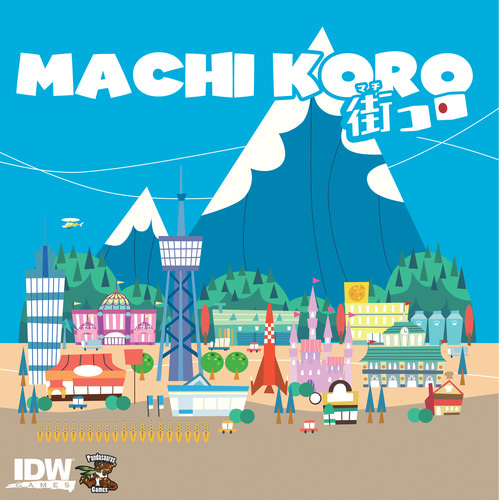
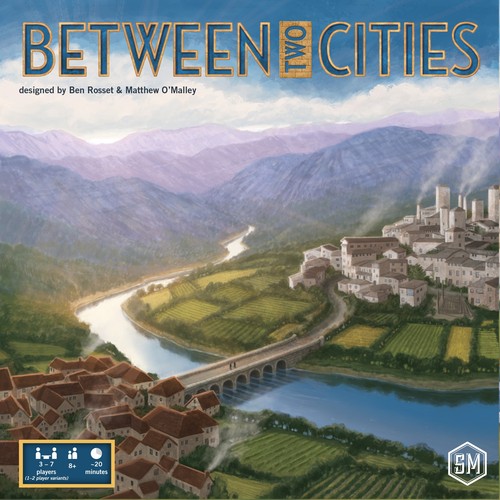
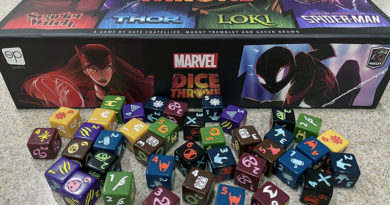
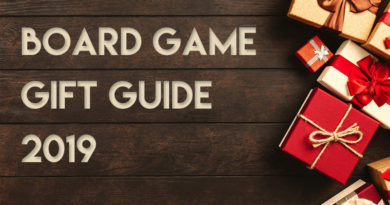
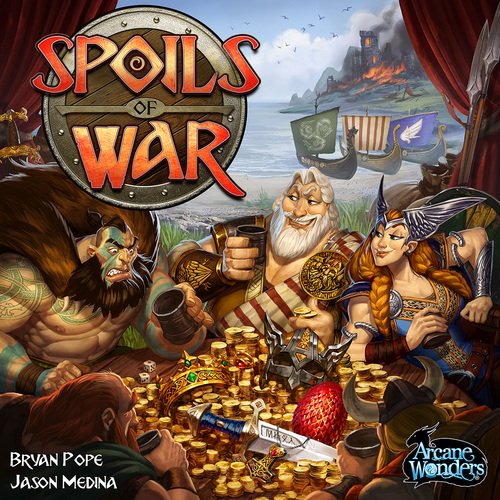
Thanks for the reviews. Favorite place on my city (San Dimas) is Home of course.
My favorite part of your city is Waterloo!
Dice and civil engineering. Seems awesome!
I agree with JJ. There isn’t much of interest in my town. Home is the thing that keeps me coming back, and thus, my favourite part. Thanks for the giveaway.
Sounds like a good fit for our family game nights! Favorite place in my city is Bertha Brock Park – a beautiful wooded park with rolling hills, a trout stream, stone bridges, and more. Just lovely.
Another fine review. I love all the Disc Golf courses in my area (DFW).
Our family loves all the parks scattered throughout our city.
I am interested to see how my family and gaming group would like this. Thanks for your reviews!
Oh, and I like Main Street, from the library, to the church, to the city park and Rec Center.
Sounds like a fun game!
I’m in St. Charles, Missouri, I love walking our historic Main Street, where Lewis & Clark launched their expedition to the West!
I love your blog posts. My favorite place in san diego is the LDS San Diego temple. Its like a fairy tale castle on the outside, but filled with the spirit inside.
The favorite part of my city are the parks (when it’s not raining) 😬
Mmmmmm dice.
Thanks for the review and giveaway!
Oh, and my favorite part of the city I live in is The Gaming Goat, my favorite of the three game stores!
Hey Trent – Great review and thanks for the giveaway. I have been on the fence about this game and I think you just tipped me.
Thanks for the contest! This is one I’ve looked at, but since I’m on a self-imposed buying embargo, I’ll just have to win it instead!
Thanks for the giveaway! I’m imposed a game buying embargo on myself, so I just have to try to win games instead!
The local library
thanks for the review and giveaway. My favorite thing about Chicago is the miles and miles of lakefront parks and beaches. My favorite thing about the Chicago suburb I live in is the game store.
My favorite part of Alton, Illinois has got to be the riverfront area. We’re just north of the confluence of the Mississippi and Missouri rivers, and a lot of great businesses and attractions are going up and being strengthened in the riverfront area. My favorite spot there is The Old Bakery Beer Company. Great beer, great casual food, awesome space. Great place to play games.
Besides my home (obviously), my favorite let of the city would be the parks. Get away from the noise that’s so dominant. Also the rugby pitch 🙂
We live in the KC, MO metro and I really enjoy going to the Zoo with the kids.
Favorite part of my city is the brewery.
Downtown, where friendly local game shop is!
My favourite part is Japanese Restaurant 🙂
I’m intrigued by Dice city. it looks more interesting than Machi Koro. MK fell flat with me; just not very interesting.
I am from Suwanee GA. Our Town Center is awesome!
Great review! My favorite part of my city is the AFK Tavern.
Man, I played this game at a friend’s house and it was really great! I liked it better than Machi Koro because I felt more involved.
Thanks for the giveaway!
Just saw that for the giveaway I need to say what I like about my town.
Hum… I would say my home because it’s comfy, but I like my local game store because they are selling used games as well so sometimes I can find a sweet bargain!
Very cool and well done explanation of the difference between the games. Both are on my list to get because they both look fun.
It seems an awesome game to play with my wife and two childrens. I’m from Coimbra, and the university is the most beautiful in the world.
I was a fan of Machi Koro when I played it, but I would have preferred if there was just a tiny bit more depth, and maybe a tad less reliance on luck. This game, Dice City, looks like it might just be exactly what I’m looking for!
This would be great to try with my kids
This looks like an amazing game. I look forward to playing it.
We enjoy exploring the busy downtown area and all of the businesses there. Amazing shops and restaurants to enjoy.
Interesting game.
Looks Fun!
McKinney, TX
My favourite part of my city is the Skydome and watching the Jay’s play (I’m in Toronto)
I’ve never played Dice City, but I’d love to try it.
The best part of where I live is the people!
I live in Dallas, TX so there’s a ton of awesome places in my city….so I would go with downtown Dallas. Amazing buildings and tons of cool little spots to enjoy.
Btw, I love Dive City. Got to play it a couple times at my game club and I would be so amped to have a copy.
Chattanooga, TN here…favorite part is being downtown!
Thanks for this review, I have read before that Dice City made up a more complete game than Machi Koro and I wanted to make sure.
I love games that incorporate a strong dice-rolling mechanic.
As always we love your blog and reviews! Thanks for the fun giveaway contest. This is one game we would like to check out soon!
Thanks for the review! Would like to give this one a try 🙂
Just moved, no favorite part yet.
Looks like a fun game!
Thanks so much for both reviews and the comparison – Dice City sounds like the one for me after reading everything. Thanks for contest.
Forgot to mention favorite part of city, the mountain foothill open spaces are what I like.
Thanks!
Played this with my wife. We both really liked it.
I LOVE the format of this review.
One of the best and most succinct formats I’ve ever seen.
Nice job. I can’t wait to try Dice City now.
Barton Springs Pool!
This is awesome! A day after commenting how this would be the city builder for the collection you guys post it as a giveaway. Thanks for the contest!
Oh….and home town. Casino, Race Track and an air force base all within an hours drive of 3 major cities. Great place.
Imperial Settlers meets Machi Koro
Thanks for the review guys! If I get this one played it may be at one of my favorite places where I live – the local library (it’s huge!)
I love that the city I live in has a revitalized old-school arcade with over 100 big box arcade & pinball games! Thanks for the chance to win.
Awesome review!
My family quite enjoys Machi Koro – I’m sure they would all love this one!
I live in a small town in Central MN – I’m fairly close to the Minneapolis/St Paul area where a majority of my gaming meetups take place!
Thanks for the contest!
Along the river in the city
We’ve got some really nice parks, many with great walking trails.
I like the library. Geek alert. I know.
My favorite part of any city is the locations where they serve Ribs! Yummmmm, Ribs!
GL All
Thanks for the contest. I live in Crown Point, IN, and my favorite thing here is Chemshawz, the local donut and comic book place. I’m not that into comics, but they have some awesome donuts.
I love reading your reviews!
The favorite part of the city where I live is my apartment. No doubt.
Favorite part of the city is by the river downtown, so beautiful.
I love Machi Koro, though the expansion makes it much better. The way you reviewed Dice City was awesome because of how much I am into MK you made me really want to buy DC. Thanks!
My favorite part of my city is the north. Lots of cities have a north.
My favorite part of the city I live in is the large hiking area just 1 mile away from my house!
I’m at Kuching, Malaysia. My favorite part will be the diverse food culture.
My favorite part of my town is an island park with a trail that leads to a dam.
I would love to give this a try. Good luck.
My favorite part of the city is the park.
Thanks for the contest!
This is actually a game I am thinking of getting. My husband’s favorite type of game is dice rolling..this piques my interest even more…thanks!
First of all thanks for the great review and contest. I really enjoyed games like Machi Koro or anything dice related 😛 My favourite part of my city is exactly where I live because there is no place that is more quiet than here 🙂 it´s very peaceful
My favorite part of the city is the music scene!
My favorite part of our town is the library. My son would probably say Six Flags. (I realize not many people live 5 minutes away from an amusement park).
I watched it played once. And people seemed to be having fun.
Thank you for your comprehensive reviews.
Would love to play this game!
Super
One of my favorite places in town is our FLGS.
thanks for the giveaway
My favorite part of the city is the library.
The lake was my favourite part of the city
Seems an interesting “Machi Koro” type game. I enjoy the parks in my town, I hope to like also the parks in this game 😉
I’ve played Machi Koro several times and really love the game. I hope to try out Dice City and see the differences for myself.
My favorite part of the city where I live is the library.
I live in a city with beautiful mountains. I love to take drives through the mountains.
My favorite part of the city (Somerville, MA) is this amazing square with shops and restaurants and benches and people and live music all the time and when they shut down traffic and people take over it is simply wonderful.
Everything is my favorited, can’t pick one. But this game looks awesome, my 3 boys will love it.
I love the local stage theater. Great to see the community come together and all the talent we have
Let us know your favorite part of the city where you live.
Home ! lol
thanks yall
LOOKS INCREDIBLE!
One of my favorite aspect of Hampton, NH is even though it is a tourist area. Everyone here is very warm and inviting
Thank you for the giveaway! Sounds like a fun game to play.
Thanks for the contest!
I love my public library!
I grew up in NJ, and I loved how I could bike everywhere as a child, even to the bookmobile!
Thanks for this contest !
My favorite part of the city is the Arts District downtown. They do a nice job with events down there
My favorite part of Tacoma is Owen Beach.
My favorite part of San Lorenzo is that it’s close to everything!